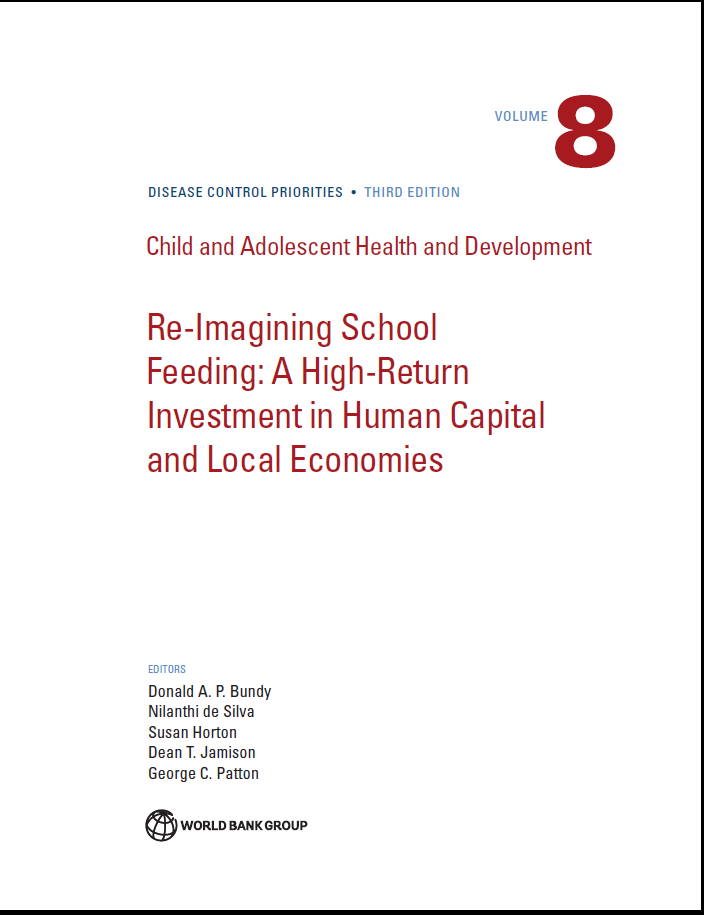Re-Imagining School Feeding : A High-Return Investment in Human Capital and Local Economies
Date
2018Author
Bundy, Donald, ed.
Silva, Nilanthi de, ed.
Horton, Susan, ed.
Jamison, Dean T., ed.
Patton, George C., ed.
Bundy, Donald
Silva, Nilanthi de
Horton, Susan
Patton, George C.
Schultz, Linda
Jamison, Dean T.
Galloway, Ray
Bing Wu, Kin
Azzopardi, Peter
Kennedy, Elissa
Coffey, Carolyn
Mokdad, Ali
Alderman, Harold
Behrman, Jere R.
Glewwe, Paul
Fernald, Lia C.
Walker, Susan P.
Watkins, Kristie L.
Fink, Günther
Georgiadis, Andreas
Viner, Russell M.
Allen, Nicholas B.
Grigorenko, Elena L
Lassi, Zohra
Moin, Anoosh
Bhutta, Zulfiqar
Drake, Lesley
Fernandes, Meena
Aurino, Elisabetta
Kiamba, Josephine
Giyose, Boitshepo
Burbano de Lara, Carmen
Alderman, Harold
Mai, Lu
Mitchell, Arlene
Gelli, Aulo
Appleby, Laura J.
Bradley, Mark
Croke, Kevin
Hollingsworth, T. Deirdre
Pullan, Rachel
Turner, Hugo C.
Graham, Hugo C.
Mitra, Sophie
Mont, Daniel
Black, Maureen M.
Gove, Amber
Merseth, Katherine A.
Sarr, Bachir
Banham, Louise
Colenso, Peter
Drake, Lesley
Plaut, Daniel
Thomas, Milan
Hill, Tara
Worthington, Jordan
Burnett, Nicholas
Walque, Damien de
Gertler, Paul
Hidrobo, Melissa
Nandi, Arindam
Behrman, Jere R.
Bhalotra, Sonia
Deolalikar, Anil B.
Laxminarayan, Ramanan
Verguet, Stéphane
Filippi, Véronique
Metadata
Show full item recordAbstract
Analysis shows that a quality education, combined with a guaranteed package of health and nutrition interventions at school, such as school feeding, can contribute to child and adolescent development and build human capital. School feeding programs can help get children into school and help them stay there, increasing enrollment and reducing absenteeism. Once children are in the classroom, these programs can contribute to their learning by avoiding hunger and enhancing cognitive abilities. The benefits are especially great for the poorest and most disadvantaged children. As highlighted in the World Bank’s 2018 World Development Report (World Bank 2018), countries need to prioritize learning, not just schooling. Children must be healthy, not hungry, if they are to match learning opportunities with the ability to learn. In the most vulnerable communities, nutrition-sensitive school meals can offer children a regular source of nutrients that are essential for their mental and physical development. And for the growing number of countries with a “double burden” of undernutrition and emerging obesity problems, well-designed school meals can help set children on the path toward more healthy diets. In Latin America, for example, where there is a growing burden of noncommunicable diseases (NCDs), school feeding programs are a key intervention in reducing undernutrition and promoting healthy diet choices. Mexico’s experience reducing sugary beverages in school cafeterias, for example, was found to be beneficial in advancing a healthy lifestyle. A large trial of school-based interventions in China also found that nutritional or
physical activity interventions alone are not as effective as a joint program that combines nutritional and educational interventions. In poor communities, economic benefits from school feeding programs are also evident—reducing poverty by boosting income for households and communities as a whole. For families, the value of meals in school is equivalent to about 10 percent of a household’s income. For families with several children, that can mean substantial savings. As a result, school feeding programs are often part of social safety nets in poor countries, and they can be a stable way to reliably target pro-poor investments into communities, as well as a system that can be scaled up rapidly to respond to crises. There are also direct economic benefits for smallholder farmers in the community. Buying local food creates stable markets, boosting local agriculture, impacting rural transformation, and strengthening local food systems. In Brazil, for example, 30 percent of all purchases for school feeding come from smallholder agriculture (Drake and others 2016). These farmers are oftentimes parents with schoolchildren, helping them break intergenerational cycles of hunger and poverty. Notably, benefits to households and communities offer important synergies. The economic growth in poor communities helps provide stability and better-quality education and health systems that promote human capital. At the same time, children and adolescents grow up to enjoy better employment and social opportunities as their communities grow.


